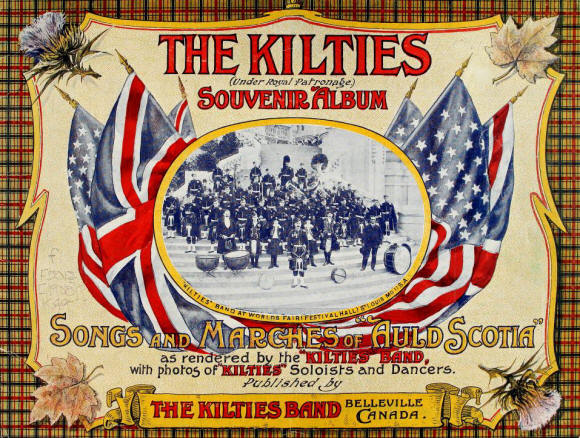|

Kilties, touring
band (1902-1933)
Photograph of the
label on a Kilties record, showing the colourful plaid with black
lettering. (Also known as the Regimental Band of the Gordon
Highlanders)
Formed in Toronto, by members of the 48th Highlanders Band, to keep
some touring commitments of that group, the Kilties Band of
Belleville, Ontario, was one of Canada's most popular international
touring bands of its day. Thomas P.J. Power and William F. Robinson
were its first bandmasters, and its membership at times included
cornetist, Mr. Voss, and pipe sergeant, David Ferguson (who also
recorded bagpipe solos for Berliner). Playing at parks and touring
on the vaudeville circuit, they eventually performed in 20
countries, appearing at the St. Louis World's Fair in 1904 and
giving two Royal Command Performances in Britain. From 1908 to 1910
they went around the world, and in 1915 played to great critical
acclaim at the Panama-San Diego Exposition.
The famous
Scotch-Canadian band, known as the "Kilties," will arrive by the
Melbourne express on Friday morning. In the evening, led by two
giant drum-majors, each well over 7 ft. in height, and headed by a
local band, they will march from the Post-Office to the Exhibition
Building, where a first concert will, be given.. Sergeant-Major
Roderick Bain McKenzie, one of the two giant drum-majors, is already
in Adelaide. He is a fine specimen of perfectly-proportioned
manhood, standing 7 ft. 1 in. in his socks, and weighing 23J stone,
he is 33 years of age. and comes of "a Scottish stock". His father,
who was born at Loch Carron, Scotland, was 7 ft. 11 in. in height,
and his mother, who belongs to the Black MaCrae clan of Kintail, and
is a native of Cape Breton, Nova Scotia, can boast a stature of 6
ft. 1 in. McKenzie, who first saw the light at Lucknow, Ontario, in
1877, has served in the British army, and still belongs.to the
Reserves. He enlisted in Canada in the second battalion of the
Gordon Highlanders, and was stationed with his regiment in Scotland,
India, and elsewhere. During the Boer war he fought in Natal under
General Buller, and subsequently under General Ian Hamilton. Of the
engagement on Spion Kop, where he was in the thick of the fight, he
carries several mementos in the shape of bullet wounds. At the
conclusion of the war he met the Kilties Band at the St. Louis
World's Fair and he joined them. "You can say," said the
sergeant-major to a representative of "The Advertiser" on Monday, "I
like Australia immensely, and I've travelled some. I am not the
giant of the Kilties Band, as Donald MeCormick, our other
drum-major, who is recognised as one of Canada's beat oarsmen, can
give me an inch in height. As for our costume, it is Canadian and it
is Scotch. Canada has adopted the kilts, and all our seven
fortresses are manned by 'the, men in kilts.' As for the quality of
tne band, well-four times it was commanded to appear at the Court of
his Majesty King Edward. One thing more-if you want to see Scotch
piping and dancing you must see Albert Johnstone, of Dundee,
Scotland, who is the champion piper of the world, and the Johnstone
troupe of dancers. But this is talking shop. Good-bye."
Sergeant-Major McKenzie got. off the chair, which was creaking under
his weight, and stooping low to avoid striking his head against the
doorway, passed out into the street.
Download
The Kilties souvenir album
here in pdf format |
